Getting Ready: In our learning activities, we will:
- Differentiate between waste that rots and waste that does not rot.
- Classify waste into that which rots and that which does not rot.
- Identify ways of managing solid waste in our localities.
- Use proper safety measures as we manage solid waste. We will at all times ensure that we and others are safe.
- Appreciate and develop interest: We will find out more about proper management of solid waste in the environment and share this information with our friends, family and community members.
- Collect waste and dispose of it properly and safely.
- Use locally available materials to make dustbins, toys and ornaments.
We will study how to manage different types of solid waste.

Activity 3.1: Learning new words
Language link: Learn the meaning of these words:

Solid Waste in my Local Environment
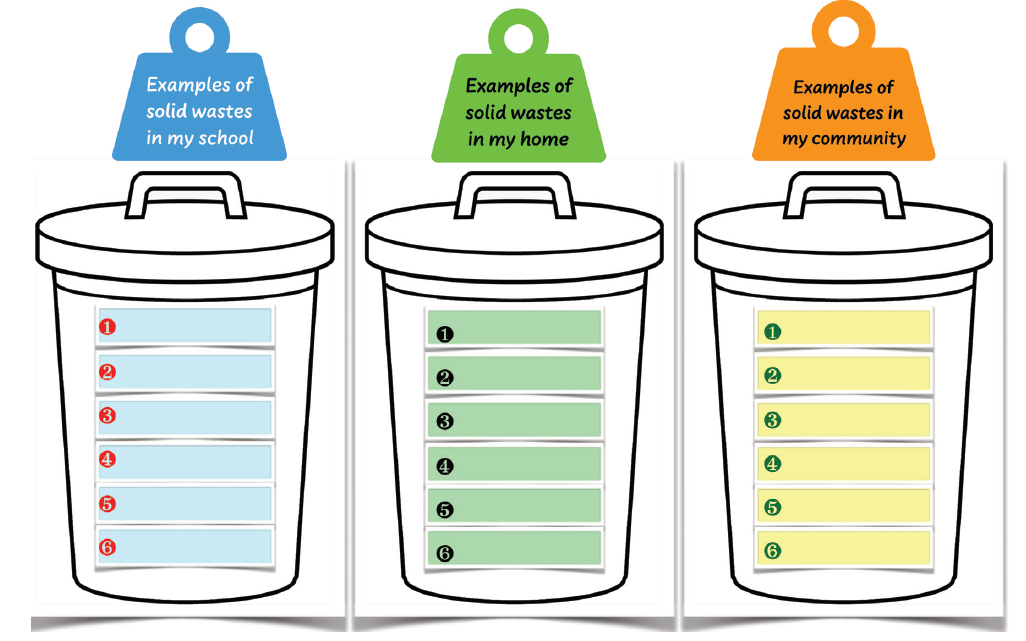
Learn more. Grow. Share the knowledge with your family and community members
Waste is what we throw away. It is what we do not need. Solid waste is what is left after using various materials to meet our needs.
Examples of solid waste in our home, school, and community environment include the following: kitchen waste, animal dung, plastics, used face masks, faulty electronics, metal cans, glass bottles and shards of broken glass.
Activity 3.3: Sorting solid waste in my local environment
Study the types of waste you observed and recorded in Activity 3.2. Identify the type of waste that rots and that which does not rot? Waste that rots is also described as waste that decomposes.
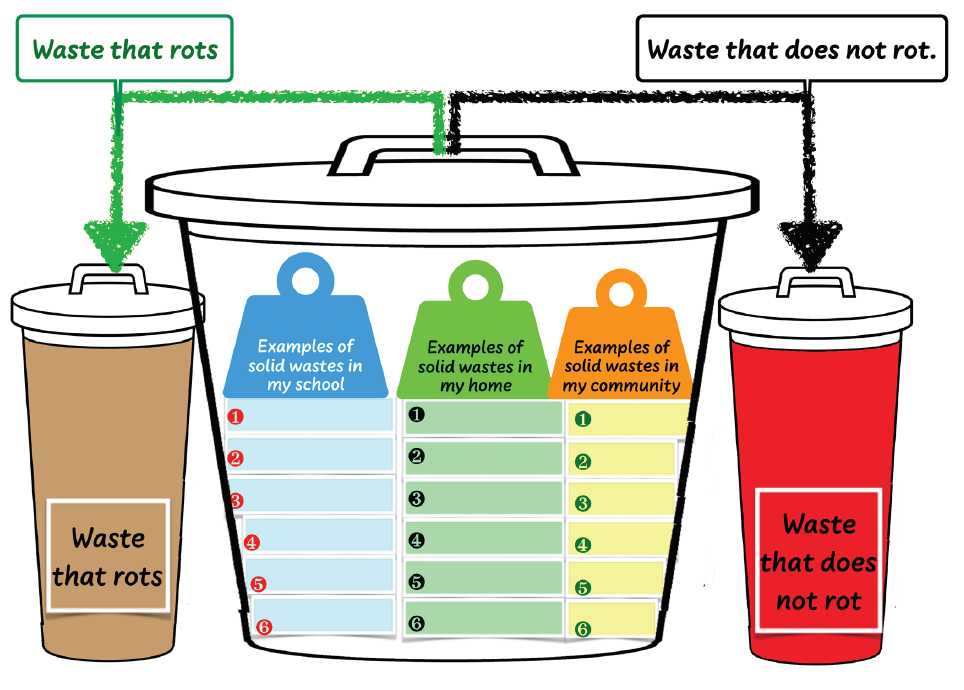
Activity 3.4: Observing precautionary measures when handling waste
Caution: Wear protective clothing such as gloves, gumboots and aprons when handling waste at all times. It is also called PPE.
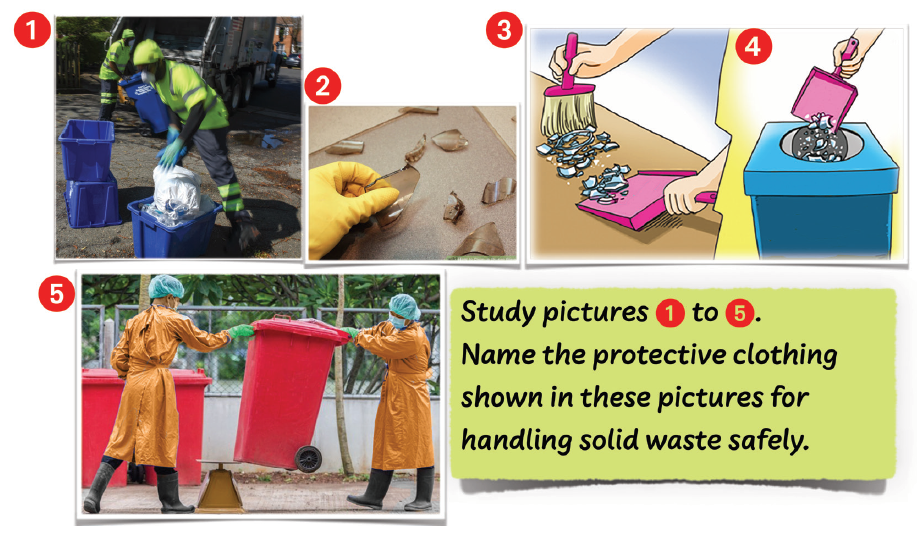
Solid Waste that decomposes and that which does not
Activity 3.5: Find out the meaning of decomposing
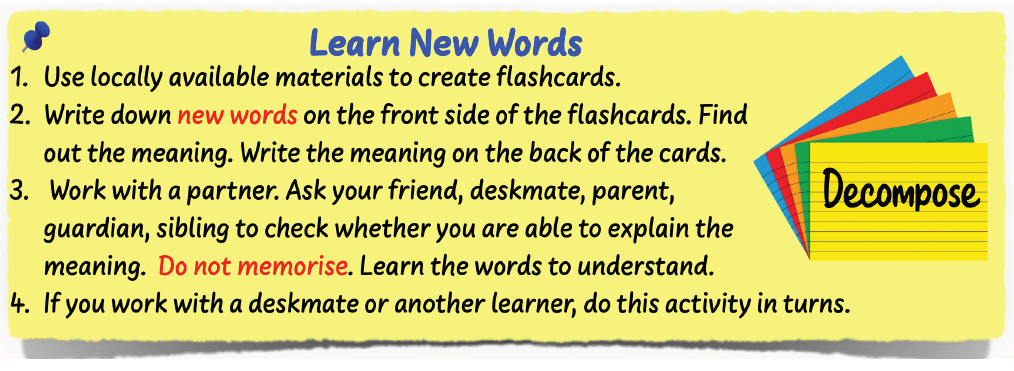
Learn more. Grow. Share the knowledge with your family and community members
- To decompose means to rot.
- Waste that decomposes is waste that rots.
Plastic bags do not decompose. They have been banned in Kenya. If you find a trader using them, report to your community leaders.
- Rusty pins
- Old torch batteries
- Pieces of broken plastic pipe
- Torn newspapers
- Broken bulbs
- Faulty mobile devices
- Broken glass
- Uprooted weeds
- Plastic cans
- Torn slippers
- Fruit peels
- Animal dung
- Used tissue paper
- Vegetable peels
- Metal rods
- Lenghts of wire
- Withered flowers
- Disposable plates
- Pieces of torn paper
- Egg shells
- Plastic bottles
- Used face masks
- Broken thermos flask
- Maize stalks
- Compost waste
- Rusty nails
- Food remains
Activity 3.7: What is waste management?
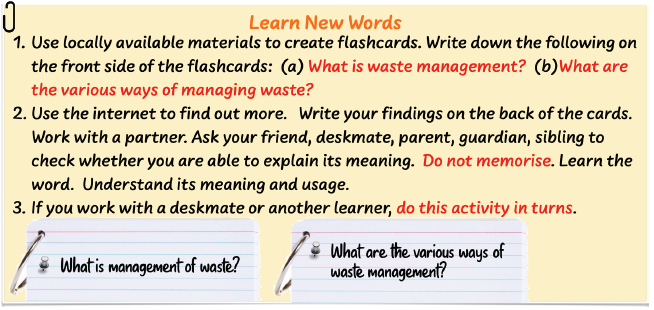
Activity 3.8: Find out more about management of solid waste

Solid Waste Management
Involve your family. Serve your community. Ask to find out. Learn. Share. Grow. Solve problems.
As citizens of our communities, we have a responsibility to manage our waste in a way that shows that we care for the environment. We can do this in various ways.
Use the Internet to find out various ways in which we can manage solid waste.
Work individually. Write five ways of managing waste: one for each finger on the picture. Compare your ideas with those of others. Share all the ideas you gather with your family and community members.

Learn more. Grow. Share the knowledge with your family and community members
- Waste, if not managed properly, pollutes the environment.
- We should manage waste properly.
- Always wear protective clothing when handling waste at home and in school.
Observe how solid waste is managed in your locality. Record your findings.
Some ways of managing waste are: 3R’s
- Reducing: This is to cut back on the use of materials.
- Re-using: This is to use an item over and over again.
- Re-cycling: This is to re-use materials as resource.
How many R’s?: Search the Internet for the R’s of managing waste. How many do you discover? Share this knowledge with others.
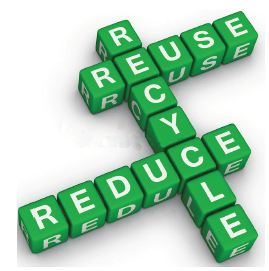
Activities and actions required to take care of waste from its production to its final proper disposal is.
Unwanted materials and objects that people have thrown away is .
Other names for waste are .
It is irresponsible to litter, which means to .
Activity 3.11: Ways of managing solid waste in our locality
Observe the type of waste in your locality. Write down various ways of managing different types of solid waste.

Activity 3.12: How can we manage different types of solid waste?
Which ones can we do without? Which ones can be reused or recycled? Look at the picture and discuss.

Managing solid waste by reducing
Activity 3.13: Ways of reducing on production of solid waste
To reduce means to cut back. The best way to reduce waste is not to produce it.
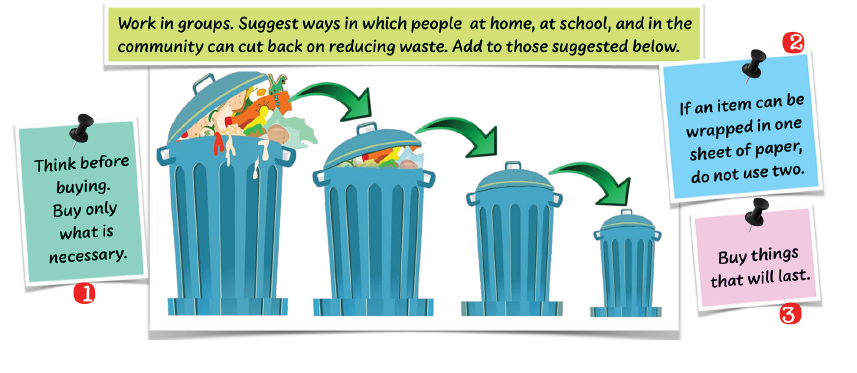
- Plastic bags do not decompose. They have been banned in Kenya. If you find a trader using them, report to your community leaders.
- Observe your home environment. Identify items that you can do without. Discuss with your parents or guardian various ways of reusing or recycling various items.
Managing solid waste by re-using
Activity 3.14: Managing waste by re-using items
Re-using means using an item that has already been used for another purpose. Work safely in groups. Discuss items that can been re-used.

Find out from each other what other items can be reused in our homes, in school, and in the community.
Search the Internet about waste management

Managing solid waste by recycling
Activity 3.15: Managing waste by recycling items
Recycling is using waste to create useful things. Recycling reduces the amount of waste in our homes, school and the community. Discuss the materials being recycled. Use the statements in the jigsaw.
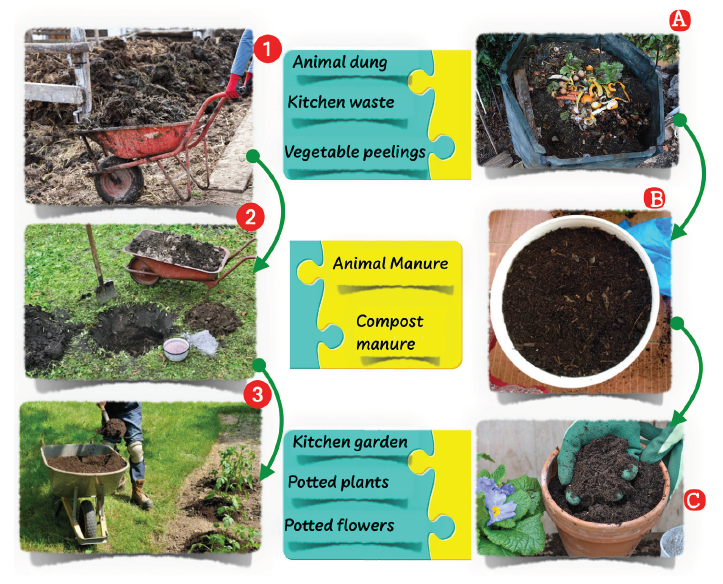
Find out from each other: What other items can be recycled in our homes, school and in the community?

Using locally available materials to make a dustbin
Activity 3.16: Identifying waste materials for making a dustbin
Work safely in groups. Discuss the waste materials that have been used.
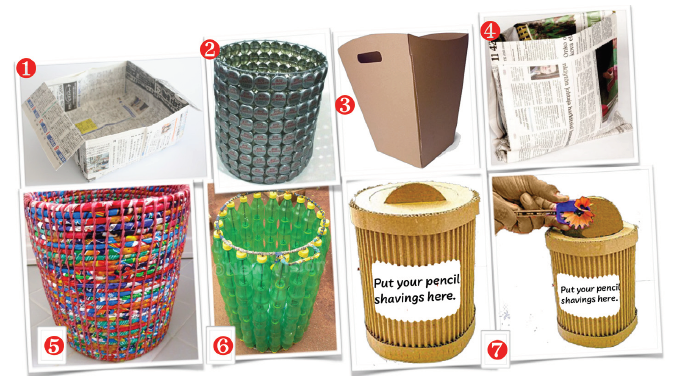
Find out from the Internet: What locally available materials can you use to make a dustbin for safe disposal of waste at home and in school? Collect the materials. Make and label your dustbins.
Activity 3.17: Collecting waste and disposing it of properly
Collect waste in school and at home. Put it in the dustbins you have made.
Using locally available materials to make toys
Activity 3.18: Identifying waste materials for making toys
Work safely in groups. Discuss the materials that have been used.
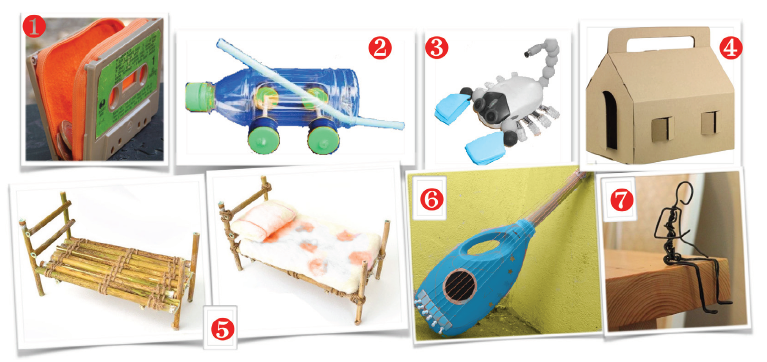
Find out from others and from the Internet: What locally available waste materials can you use to make toys? Collect them and make toys.
Using locally available materials to make ornaments
Activity 3.19: Using a straw to make a bracelet
Neema made a simple bracelet. She used a pencil sharpener and a straw. She followed steps 1 to 6.
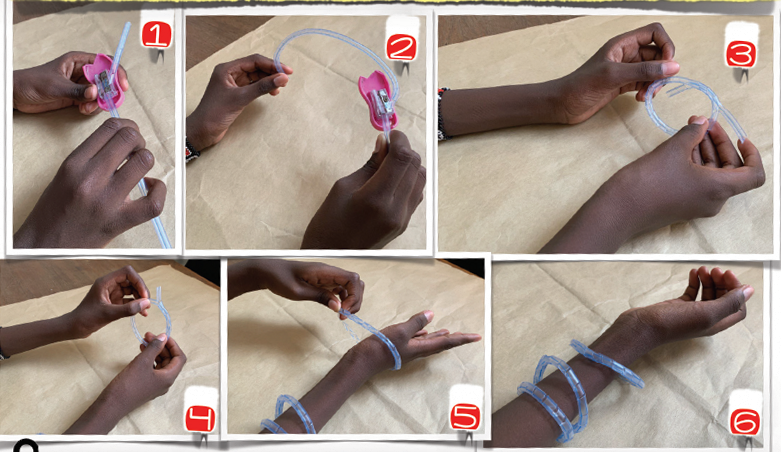
Collect locally available materials and make simple ornaments. Take pictures and videos as you do it. Show the items, the videos and the pictures to others. What will you make? What materials will you use?
Activity 3.20: Using digital devices
With the guidance of your teacher, use the Internet to find out ways of managing different types of solid waste by: re-using, reducing and recycling.
- With permission from your parent or guardian, pick an item that you can re-use or recycle. Create something new out of it.
- Take pictures and videos as you carry out this activity. Show them to your teachers and other learners.
Summary
Learn more. Grow. Share the knowledge with your family and community members
- Solid waste can be grouped into that which decomposes and that which does not decompose. Waste that decomposes include plants remains in our houses, farms and also animal waste.
- Waste that does not rot includes plastics, broken glass and electronic waste.
- Waste can be managed by reducing the production of waste; re-using the waste; and recycling the waste to make new products.
Involve your family. Serve your community. Ask to find out. Learn. Share. Grow. Solve problems.
Home activity: With the guidance of your parent or guardian, or someone in the community, do the following:
- Identify different solid wastes in your home and community area.
- Sort the waste into that which rots and that which does not rot.
- Place the wastes in separate dustbins.
- Use the wastes that rot to make compost.
- Make a banner to educate people on how to manage waste in your locality.
- Use waste plastic bottles to make simple irrigators as shown in pictures 1 to 3 below.
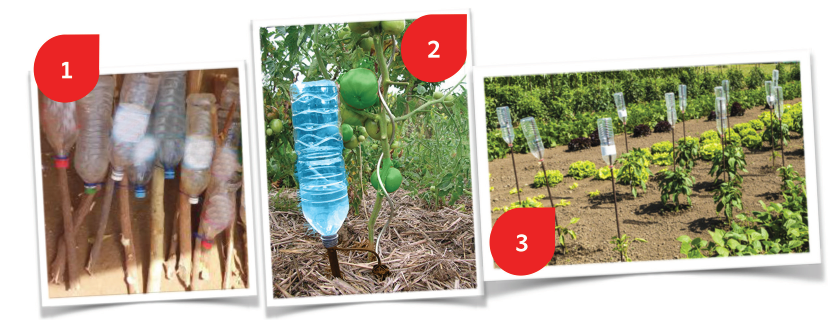
Activity 3.21: Let us talk about solid waste management
These learners are talking about the type of waste they are collecting. What do you think they are saying? Write a short conversation about their activity. In your short essay , answer these questions:
- What are they doing?
- Why is it important?
- What type of waste do you think they are collecting?
- How should hey sort the waste?
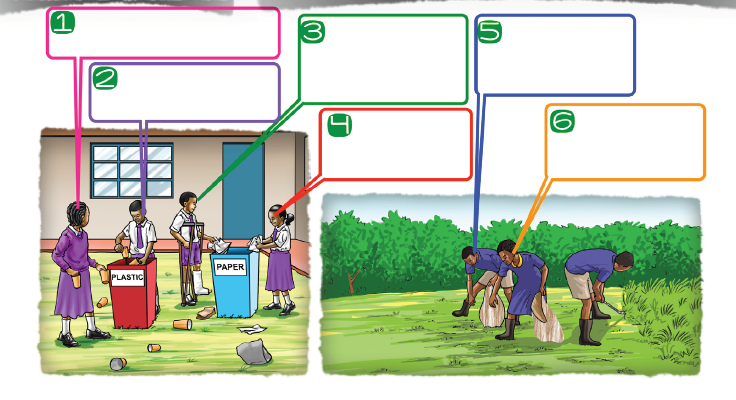
Let us sort and manage waste in our locality
Draw bins for different types of wastes. Label them. Show what type of waste will be disposed of in each bin. Show what can be re-used or recycled.

We often call our planet Mother Earth. Write a short letter to her. Pledge your support. Tell her how you manage waste in order to support her.
Submit your letter to a newspaper publisher of your choice that publishes content for the young. Check for their email address in the weekend newspapers.